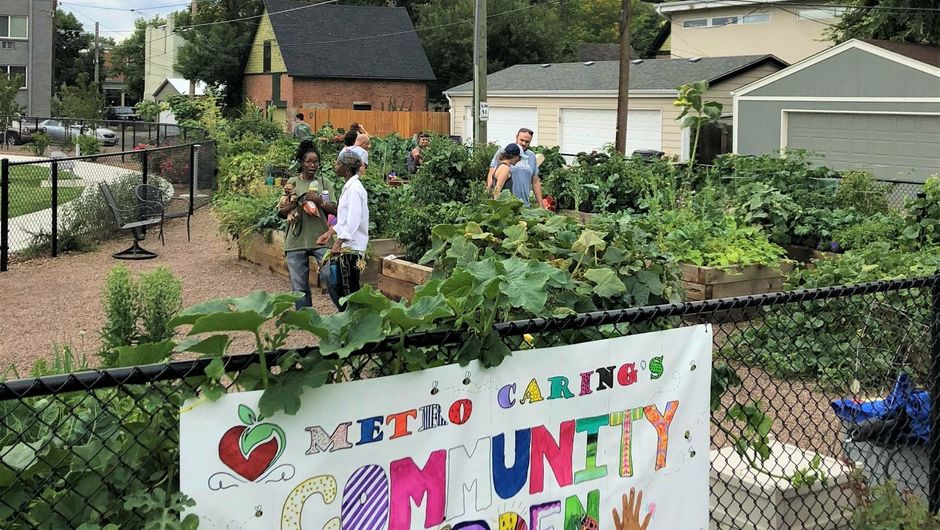
Feeding Student Achievement by Fighting for Food Justice
Teach For America alumni are taking on the fight to improve students’ academic, physical, and emotional wellbeing by making nutritious meals more accessible in their schools, homes, and communities.
Over 40 million Americans struggle with hunger each year, including nearly 13 million students who regularly go to school hungry.
That means one in six children in the United States aren’t able to perform at their full potential in the classroom because they lack consistent access to affordable, nutritious foods.
This problem is known as “food insecurity.” It has multiple, systemic causes, and its symptoms can be easy to miss—the child whose lunchbox contains just chips and soda, or the one who’s sluggish until lunchtime for lack of breakfast. But its effects are far-reaching: Food insecurity can have a profound negative effect on kids’ school attendance and academic performance.
There is a growing number of community leaders who are fighting to change the status quo of our country's food system as part of the food justice movement, which asserts that all communities have the right to grow, sell, and eat healthy foods. These leaders are social entrepreneurs, aspiring policymakers, community organizers, and executives, including many Teach For America alumni, united in their goal to make sure all children in this country receive the nutrition necessary to learn, grow, and lead.
Their Students’ Lunchboxes
For many of these alumni, the turning point that galvanized them to fight food insecurity was their students’ lunchboxes. They can vividly remember their students’ lunches, even years later: Flaming Hot Cheetos. Mountain Dew. Cool Ranch Doritos. Skittles. Sunny D-Lite.
Meals like these are often all that is available in the corner stores that residents of low-income communities rely on for quick, accessible, and ready-to-eat meals. Plus, a diet of fresh fruits and vegetables is pricier than a diet of processed foods and refined grains: approximately $1.50 more per day per person. For low-income families relying on Supplemental Nutrition Assistance Program (SNAP) benefits, which allots $1.86 per meal per person, that extra $1.50 adds up.
And preparing a fresh meal daily isn’t just cost prohibitive: It can also be time prohibitive for parents working multiple jobs and long shifts, especially for those living in neighborhoods with few markets offering healthy food. When there is little time to shop for and prepare meals, deli meats and fast foods are easy ways to fill up on affordable foods.
“I would have lunch with my students sometimes as a reward or a bonding moment. I recall one time when I had lunch with one of my students, and she was so excited. She took out her lunch and I saw it was two bags of Cheetos, a small Sunny D-Lite, and a little water bottle,” says Catarina Rivera (New York ’07), a program manager with City Harvest, New York City’s largest food rescue organization. “And it really hit me: ‘This is what she’s going to eat for lunch, this is what’s going to fuel her.’ I was struck by it.”
These snacks and processed meals fail to give students the vitamins and nutrients they need to nourish their growing minds. Simply put: When students are eating healthy meals, they tend to perform better on tests, and have higher school attendance. Children who consistently eat fresh foods are also at lower risk of developing obesity, high blood pressure, diabetes, and other health problems.
“I had students who didn’t eat all day until lunchtime, or they had Cheetos in the morning with soda,” says Sisi Dong Brinn (Baltimore ’08), the chief impact officer at Metro Caring, a Denver-based anti-hunger, anti-poverty nonprofit organization. “I thought: ‘The stakes are so high for my kids. How can we expect our kids to perform if their basic needs—like healthy food—are not being met?’”
Enhancing School Lunch and Breakfast Programs
Fortunately, many schools now provide free breakfast and lunch and, as a result, supply two out of three of their students’ daily meals.
However, it’s not a perfect solution. Some school meals can still be as unhealthy as the processed foods and snacks they’re trying to replace—think pizza and chocolate milk. And the timing of the school-served meals can also prove difficult for some students, as Sara John (Baltimore ’11) discovered in her classroom.
Sara noticed that many of her students would not make it to school in time for the breakfast provided there, because they had to take the city bus to school and often faced delays.
As a result, some of her students would not have an opportunity to eat until 1 p.m. So Sara helped implement a program called “Breakfast After the Bell,” which shifted breakfast to homeroom time, after first period. This allowed children taking the city bus to have a balanced school breakfast to start their day.
“While we didn’t conduct a formal evaluation, we see a significant increase in the number of students participating in the school breakfast program,” Sara says. “There may even have been increases in attendance, according to the principal.”
Sara is now a doctoral candidate at the Tufts University Friedman School of Nutrition Science and Policy, where she is researching SNAP for her dissertation. Her focus is on improving the healthfulness of SNAP by integrating program changes, including ideas such as financial incentives for fruits and vegetables and disbursing SNAP benefits more frequently than the current 30 days.
Multiple studies show that toward the end of month, when recipients’ SNAP benefits are running out, there are notable peaks in food insecurity, worsening student test scores, and even increased hospital admissions for diabetes. Similar to her “Breakfast After the Bell” program, Sara hopes that by suggesting policy changes to when and how SNAP benefits are dispersed, she could possibly help address these issues at a more macro level.
Making Vendors Commit to Healthy Ingredients
Sometimes the problem with school meals stems from long-standing contracts with certain vendors. In New Orleans after Hurricane Katrina, Andrea Chen (Greater New Orleans ’04)—co-founder and executive director of Propeller, a nonprofit that develops and supports entrepreneurs tackling disparities in food, water, health, and education--was able to secure healthy food vendors for over 20 charter schools.
“Right after Katrina, when schools were just getting relaunched, I recall that the food was just terrible. Children were served hamburgers that were still frozen,” Andrea says. To help New Orleans students, Propeller launched the Healthy School Food Collaborative (HSFC) initiative in partnership with an entrepreneur from KIPP, the Kellogg Foundation, and 20 charter schools that wanted to pool together their resources to find better, healthier vendors for their students.
In order to work with any of the schools within the HSFC, vendors had to commit to standards that ensured children were eating meals sourced from healthy, fresh, and local ingredients: no high-fructose corn syrup in their meals, fresh fruits, everything prepared from scratch, no canned food, no hormones in the milk, and five percent minimum local procurement.
The HSFC is now providing meals to nearly half of New Orleans’s public school students. In 2017, the HSFC provided over 17,689 students with 1.4 million healthy breakfasts, 2 million lunches, 600,000 snacks, and 200,000 suppers.

Improving Food Assistance Services
Beyond school meal programs, some alumni are working to rethink and improve our nation’s food assistance services. While these programs help millions of families access meals in hard times, these services are not always the best sources for healthy, nutritious foods served with dignity: At most food pantries, you get a brown bag, usually filled with non-perishable items that supermarkets got rid of.
On separate sides of the country, Catarina and Sisi are part of the movement to make such food assistance more nutritious and more dignified.
In New York, Catarina is proud to work for City Harvest, which helps recover food that would have otherwise gone to waste from farms, restaurants, groceries, and manufacturers—a practice known as food rescue. City Harvest rescues over 167,000 lbs of food every day, and redistributes it to New Yorkers in need. As part of its commitment to provide nutritious foods to New Yorkers, over half of the food City Harvest delivers is fresh fruits and vegetables, according to Catarina.
As part of her work, Catarina organizes the Washington Heights/Inwood Food Council, which helps residents of those Manhattan neighborhoods develop pathways to food justice in their communities. They share meals and traditional food knowledge through potlucks and workshops. Since its inception, the council has expanded into a two-plot growing space and regularly hosts a series of community potlucks.
“Food is something that unites all of us. We all have to eat, and food is also a social activity, as well as tied to culture,” Catarina says. “People have to share food together, and it’s a way of showing love for many people, to be able to provide food.”
In Denver, Metro Caring operates a fresh foods market that allows participants to choose from a wide selection of nutritious foods based on their dietary needs and preferences. Participants in Metro Caring can visit the market and leave with a week's supply of groceries, including fresh fruits and vegetables, whole grains, dairy and lean protein.
The market is stocked with foods that would be wasted from stores like Trader Joe's and Whole Food; all of that gets rescued and sorted into Metro Caring’s market.
“If you were to walk through our market, you would see aisles for produce, protein, meat—just like at a grocery store,” Sisi says. This market, which served 65,000 people in 2017, saved shoppers an average of $250 a month in grocery costs while still providing them the dignity of choice.
“Similar to an excellent school, we do not think that your income or zip code should dictate the access you have to healthy food,” Sisi says.
Tackling the Systemic Causes of Food Insecurity
Utilities, transportation, accessible markets, a stocked pantry, and, of course, the time, money, and energy to shop and cook—these all are factors in a family’s ability to buy and prepare fresh foods, ones that tend to be overlooked. Take housing, for example. Access to a kitchen equipped with a working refrigerator, stove, or even a microwave is not always a guarantee for low-income families. This makes it much more difficult for families to prepare and store healthy meals for leftovers or school lunches, even if they are able to get fresh produce.
“Food access is complex. It’s not just about putting a supermarket somewhere. Price and access to transportation are key factors in whether someone can obtain healthy foods in their neighborhood. Choice is not choice if people don’t have the money or transportation to access that choice,” Catarina says. “Quality also comes into play, as poorer quality produce is more often found in lower-income neighborhoods when compared to others.”
At Metro Caring, Sisi and her colleagues work to not just provide short-term food relief, but also address the root causes of hunger: poverty. Metro Caring’s holistic programming includes “wrap-around,” nutrition, and gardening services. The diet-related illnesses that are results of food insecurity are addressed in diabetes self-management and prevention courses, so participants have the tools to navigate decisions about food and health.
Metro Caring’s programs also help remove some of the barriers participants may encounter preventing them from being able to purchase healthy foods. Its ID assistance program helps people who need identification, which is essential for obtaining employment, housing, healthcare, and other vital services. The utilities assistance program helps families unable to afford the heat, electricity, and gas necessary to cook and store food. And its workforce development program helps to train individuals for jobs that earn above minimum wage in Colorado.
Metro Caring also operates community gardens that allow participants to grow their own food for their families and communities. Sisi says: “Our belief is to disrupt the charitable food bank system, and move to a philosophy of doing ‘with’ our community and not ‘for’ them—‘Solidarity, not charity.’”
Food Unites Us All
A meal is greater than the sum of its ingredients. By fighting to bring equity to the food system, Sara, Andrea, Sisi, Catarina, and so many others are not only doing their part to protect students from the harmful effects of food insecurity: They’re helping to empower these children’s communities and disrupt inequitable systems as well.
“When we think about issues of equity, we are talking about the same systems. Access to educational equity, healthcare equity, economic equity, and food equity are all interrelated. And equity is about who has privilege and power, and who does not,” explains Sisi. “We have farmer’s markets, Community Supported Agriculture (CSA) programs, small batch kombucha businesses…What we all need to do is ask ourselves: ‘Who is this for? Who has access to this?’ If the people who are historically marginalized do not, then we need to take it upon ourselves to disrupt those spaces and systems.”
“Food unites every single one of us as humans—it is a basic need,” she adds. “So, how we can we take steps to ensure that it is a right?”
Food Justice Initiatives
To learn more about innovators who are fighting food insecurity within their own communities, check out these initiatives:
Sign up to receive articles like this in your inbox!
Thanks for signing up!
Content is loading...









